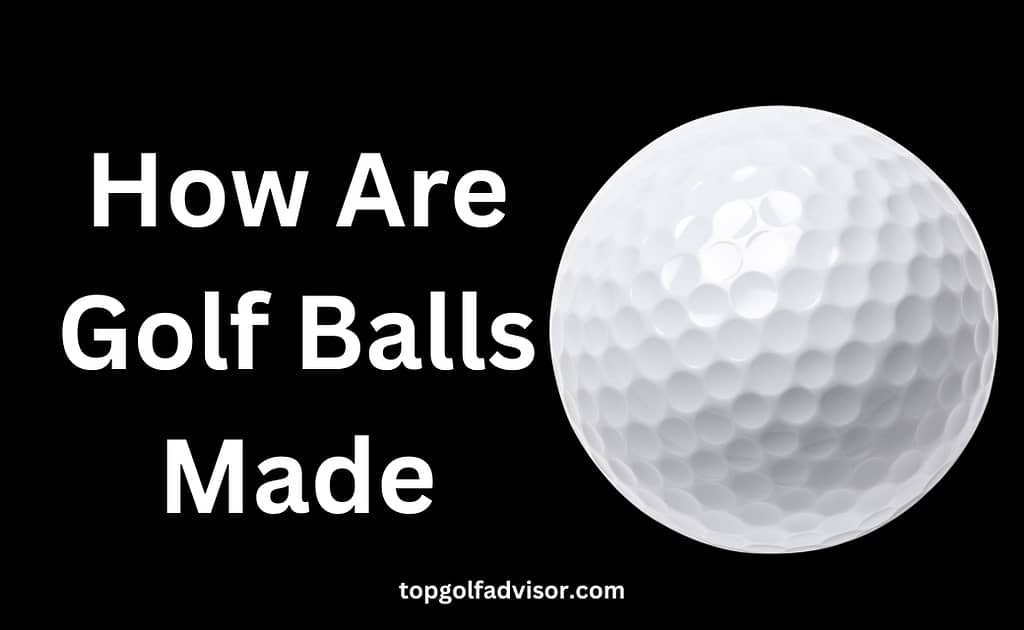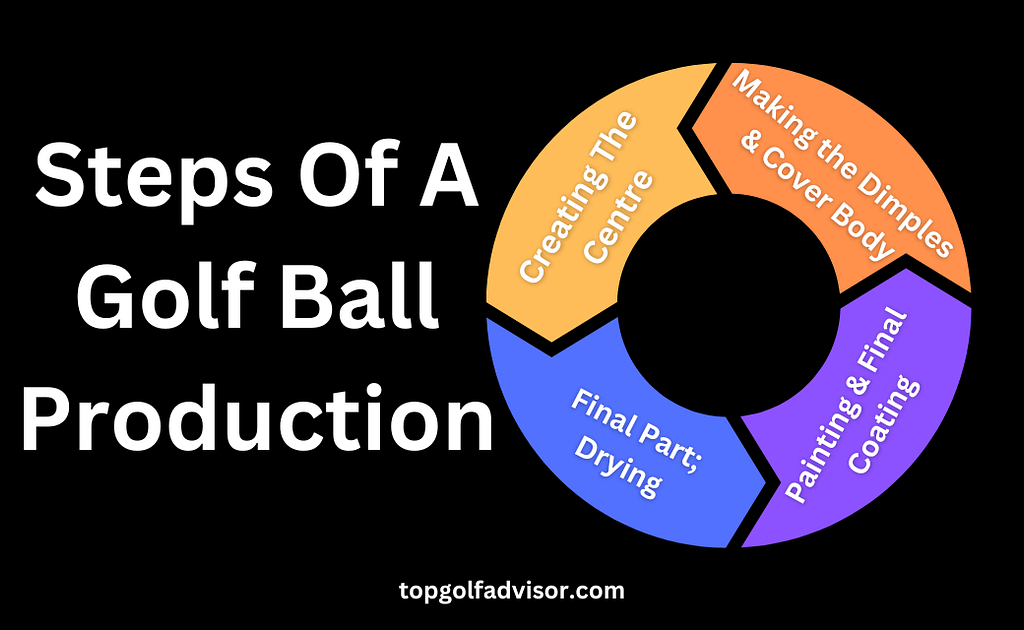Today’s golf ball has undergone extensive modification to become what it is today. Despite being a discipline that has been practiced since the 80s BC, golf is a sport that has seen numerous evolutions. Similar to golf, the balls have changed over time. They have changed from their original softball composed of leather and feathers to their current composition. Therefore, it’s common to question how are golf balls made.
In today’s blog, we’ll dive deep into construction and manufacturing and learn about how these small spheres come into being. If you’re keen on learning the industry’s dynamics, read the blog till the end for some fun facts.

What Is The Background Of A Golf Ball?
Scottish in origin, golf is one of the most popular sports worldwide. More than 24 million individuals play golf in the US alone, including 8,000 professionals.
Both players and spectators enjoy watching golf matches worldwide, and since the 1960s, they have been extensively covered by television. There’s even a satellite channel dedicated to golf and many computer games.
Using a variety of clubs, players must drive a little ball into each of the nine or eighteen holes on a course that has obstacles to score as few strokes as possible.
A player may carry up to 14 different clubs in different sizes, forms, and lengths. The British golf ball is marginally smaller than the 1.68-inch (4.26-cm) minimum diameter required for usage in the United States.
Before jumping into the main part of the blog, we need to know the history of how are golf balls made.
Golf Ball Rule According to USGA
Rules about the ball’s maximum weight, minimal size, spherical symmetry, beginning velocity, and overall distance have been established by the United States Golf Association (USGA). The ball’s weight must be circularly symmetrical and not exceed 1.62 oz (45.93 g). When measured on equipment certified by the USGA, the velocity cannot be higher than 250 feet (75 m) per sec (255 feet [76.5 m] per second maximum).
According to the overall distance guideline, the ball cannot roll or carry further than 280 yards (84 meters) on average (296.8 yards [89 meters] at most). Every year, organizations revise these regulations.
There are currently about 850 ball models that meet these requirements. Balls that still meet USGA regulations but are roughly 2% bigger than regular balls have just been released. These balls shoot farther and straighter because of their thicker, tougher coverings and softer cores.
What Are The Raw Materials In Making Golf Balls?
Before we jump into the production process of how are golf balls made, we need to understand the materials involved. Rubber and plastic make up the majority of a golf ball’s composition. A strong rubber core and a long-lasting thermoplastic (ionomer resin) cover make up a two-piece ball. To shape the rubber into a sphere, you must first heat and compress it into a hard block.
The three-piece ball comprises an ionomer or balata elastic cover and a smaller rigid rubber or full of liquid center with rubber thread coiled around it under tension.
The 1970s saw major advancements in the ball’s interior courtesy of a petroleum-based polymer known as polybutadiene. This material was too soft even if it had greater bounce. Zinc, according to research at Spalding, strengthened the material. The other manufacturers soon adopted this reinforced polybutadiene on a large scale.
How Are Golf Balls Made?
Despite appearances, a golf ball undergoes through a series of phases involving up to 80 separate processes depending on the type of ball. In addition, some balls require up to thirty days and three inspections to be certified as golf balls.
Nonetheless, the primary manufacturers of the most popular golf balls in the world use a procedure that cuts the number of phases in half, speeding up development and cutting down on manufacturing time to only one day.
Steps Of A Golf Ball Production:
Creating The Centre:
The objective is to form a spherical core of about 1.5 in (3.75 cm). Usually made of styrene butadiene rubber (SBR), or rubber that bounces, this material is utilized. A paste is created by combining different chemical substances. This produces a rubbery substance that is cooled between two big rollers and stretched like pizza dough.
After the core material has been assembled, it passes into a particular device known as an extruder. The weight is then put through equipment that uses a mold to change its shape, giving it the appearance of big rubber blocks or sugar clouds.
Once the part has changed shape and form, it is brought to a pressure molding machine. The cubes are inserted into a steel mold by an operator.
It’s interesting to note that the color of the studs, which are the outcome of combining several elements, varies according to the kind of material and ball that will be produced.
Approximately a metric ton of force is delivered once they are in position. The method used to create the ball’s core is called “bake molding” since it involves applying pressure and heat.
Making the Dimples & Cover Body:
Once the ball core is formed and cooled, the operator often covers the mold with a piece of perforated plexiglass. Doing this keeps the mold’s leftovers in place, allowing a vacuum to pick up only the ball. After that, the extra rubber left on the plexiglass piece is removed and recycled.
The golf ball’s outer layer is created using injection or compression molding techniques on a different molding machine using the cores. During this phase of how are golf balls made, the balls get their distinctive dimples, enabling them to go farther and faster toward their destination, the green.
A melted thermoplastic ionomer is injected into a mold cavity with the core centered within it through a clamping mechanism during the injection molding. The shell material sticks to the core, assuming the final ball’s dimpled shape and size due to pressure and high temperatures. The fasteners pull back to release the completed balls when the plastic cools and hardens.
The ionomer shell is placed into the mold, which is made up of two hollow hemispheres, in a different way and aspect of compression molding. After being gathered around the core, they are heated to extremely high temperatures and then compressed.
Painting & Final Coating
The fresh balls are often cleaned after being dropped into a barrel once they have formed. Because of the molds used in the production process, these procedures typically leave traces of plastic all over the ball’s circumference. The removal process comes next.
An automated machine for milling removes superfluous plastic to smooth and imperfection-free polish the ball. After that, the factory moves the balls to a quality control station. The ball will only advance to the next round with a uniform polish.
After quality-checking, the next step is the labeling phase. At this final stage, stamps or other symbols get imprinted with ink and applied to the balls by robotic arms consisting of engraved steel pads.
Typically, the pads imprint the player’s number, brand, kind, and model of the corporation on every ball. Once they apply the paint, the balls get exposed to UV light or another drying method to keep the ink intact.
Certain balls get treated with polyurethane to provide further protection against ball-specific ink stains. Additionally, they occasionally have customized engravings placed on them when appropriate.
Final Part; Drying:
Eventually, after applying various specifications or customizations, they are moved to a drying machine and typically heated for a few minutes to 66ºC. After production, the balls are prepared for packaging and delivery to retail locations where thousands of golf enthusiasts and players will use them to engage in their love of the game.

Quality Control On Golf Ball Manufacturing
Besides employing computers and monitors to oversee production, three-piece balls undergo X-ray testing to ensure their centers are precisely spherical when we discuss how are golf balls made. Golf balls with wound construction and compression molding are also rated using compression.
However, when used with two-piece balls, these scores are meaningless. Rather, the coefficiency rating—the ratio of the ball’s initial speed to its return speed following impact with a metal plate—is used to evaluate these balls. The factor of restitution is calculated using this method.
Mechanical testing also ensures the ball meets the USGA’s requirements. Specialized equipment has been developed to measure wind resistance and lift action; some manufacturers even use wind tunnels.
A golf ball’s accuracy is determined by its statistical accuracy area (SAA), also known as its dispersion area. The variations of the ball’s performance in the carry and left/right of the centerline directions determine the SAA value for a particular ball. The elliptical landing area equivalent is computed using these variations. Also, check our blog on How Many Centimeters Is A Golf Ball.
What Are The Different Types Of Golf Balls?
The following is the classification of how are golf balls made and their respective types:
- Two-layer: This kind of ball has a soft inside, but its cover is more durable. Longer distances are conceivable with this kind of ball, but controlling its effects and potential unanticipated events is more challenging. For amateur and professional low-handicap golfers, it is the ball of choice.
- Three-layer: Its core is likewise soft, just like the two-layer model, but it differs in that the third layer is composed of urethane, which is why medium handicap players typically opt for this model. All of this aims to have far more control over short shots.
- Two compressed layers. In contrast, this one has a soft cover and a hardcore. This explains why the construction of these balls is complicated. Although this ball can go a shorter distance, the player using it has improved shot control. This kind of ball is great for novices just beginning to play this sport or players with severe handicaps because it emphasizes control and instruction above strength to produce the desired result.
- Multi-layer: The balls with multiple layers are specifically chosen because the different ways they are wrapped around the core improve the accuracy of the strokes. The number of intermediary layers that increase the irons’ spin rises with their proximity to the drive and the total amount of layers in the core. Ultimately, the degree of control on short shots increases with the number of outer layers.
Thus, that’s a lesson on the manufacturing process of golf balls. You may use all of this knowledge on the course, and depending on the facilities and weather, you can choose the best option.
Final Words
How are golf balls made is essential to know if you’re keen on taking golf seriously. Understanding the construction from the get-go makes things easier to grasp in the long run. Therefore, this blog checks all the boxes on what you need to know regarding the manufacturing industry.
FAQs
Are there rubber bands inside of golf balls?
The inner workings of a contemporary golf ball are still derived from the rubber’s flexibility. Rubber cores that are manufactured quickly have taken the role of the bands. Further layers, often called mantles, are made of either plastic or rubber, depending on how the golf ball is designed.
What makes a golf ball bounce?
The ball’s kinetic energy must be expended when it strikes the ground. The higher the possibility of energy, the greater the kinetic energy, and the greater the kinetic power, the higher the bounce! Many of it returns to the ball, giving it more impetus to shoot back into the air!
How Are Golf Balls Made Are They Painted?
A bad shot can result from a golf ball with inadequate paint. Although it could appear entirely aesthetic, a constant ball results from the paint application’s consistency. takeoff
